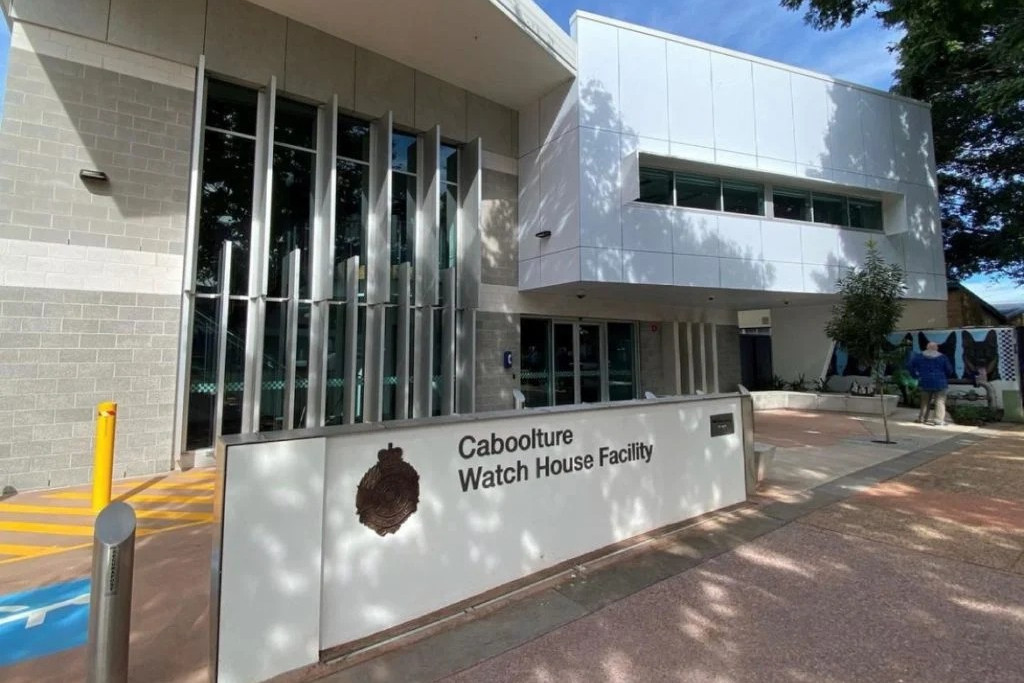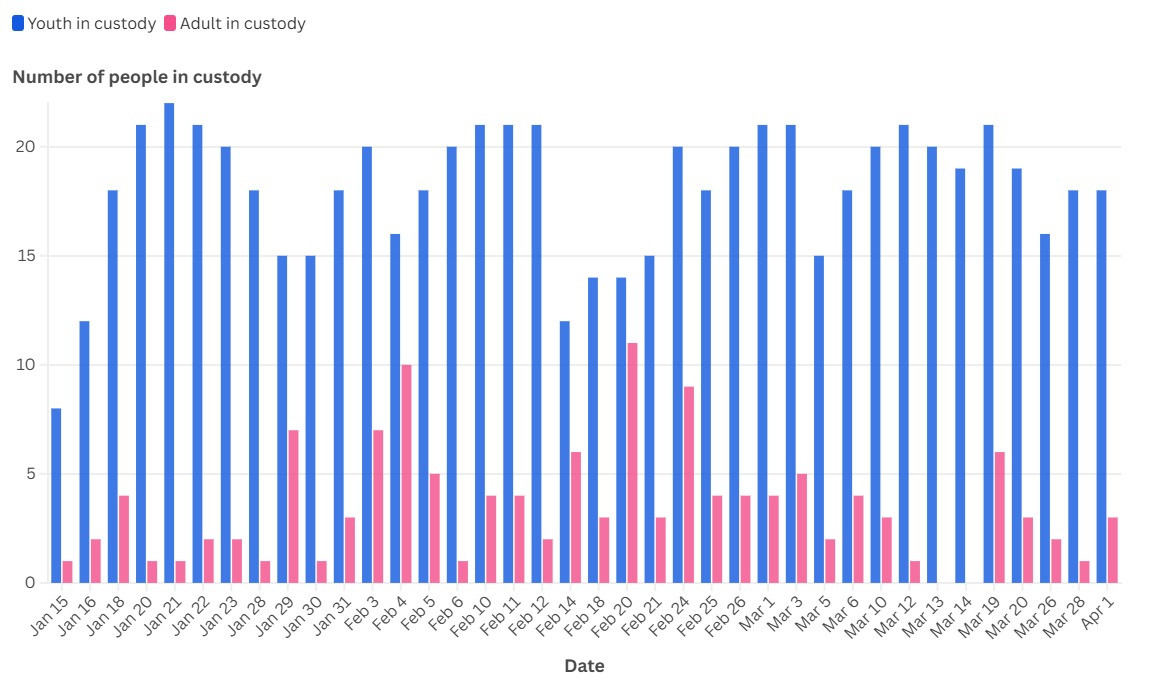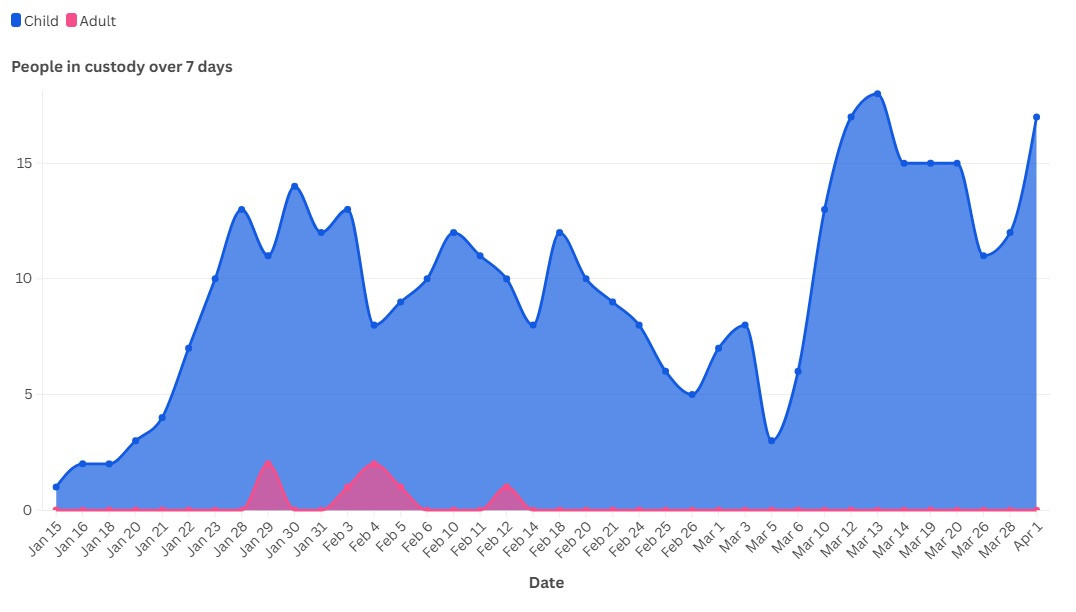News
5 August, 2025
Damning data for detained kids
OVER half the children held at the Caboolture Watch House this year were kept for over 72 hours, at least twice longer than the time recommended by the Queensland Human Rights Commission (QHRC).

In one case a child was held for nearly a month, with child advocates saying long custody times are “unacceptable”, “harmful” and expose children to potential ongoing abuse, including isolation and deprivation of food.
Figures revealed in the recently released Queensland Police Service’s (QPS) 2025 Watch House Review showed that children remanded or sentenced in Queensland were spending an average of 161 hours (6.7 days) in watch houses around the state - well above the accepted 72-hour maximum.
Daily Watch House Custody Sheets examined by The Sentinel showed that between January and March, Caboolture Watch House consistently had more children in custody than any other watch house in the state. Some periods of time had 20 times more children than adults in custody (Graph 1).
During January and March, there was always at least one child held longer than seven days, with as many as 18 out of 20 children in custody detained for over a week. During the same time, less than five adults were held for longer than seven days (see Graph 2).
The longest time a child was held at Caboolture Watch House, awaiting acceptance to a Youth Detention Centre, was 28 days. According to a QPS spokesperson, there were 329 children held in Caboolture Watch House from 1 January 2025 to 30 June 2025. Of those, 208 children were held longer than 72 hours, awaiting acceptance to a Youth Detention Centre.
The age of children held at Caboolture Watch House during this period was 11 to 17 years of age. The Review also revealed that approximately 10 per cent of watch house admissions state-wide were children.
CEO of youth legal support service Youth Advocacy Centre (YAC), Katherine Hayes, said the Caboolture Watch House was “rebadged” as the Caboolture Youth Hub, to deal with an overflow of children from detention centres to adult watch houses.
“Over the summer peak period, children as young as 12 or 13 would be held in the Caboolture Watch House for up to 20 days at a time, some of them from as far as north as Cairns or even Aurukun,” she said. “It is unacceptable for any number of children to be held in a watch house, but it is particularly harmful for young children to be held in harsh conditions with very little meaningful supports. We have had clients (across QLD) reporting harsh treatment by guards, such as rough handling, being sworn at, or being deprived of food, warmth or a change of clothes even after several days.”
The QPS 2025 Watch House Review emphasised some of the existing concerns around keeping children in adult watch houses, including inadequate space, privacy, natural light or physical and psychological support.
QHR Commissioner McDougall said the Watch House Review confirmed poor ventilation, overcrowding, unsanitary conditions, high rates of self-harm in some watch houses, and cases of children detained with adults. “These conditions create health and safety risks for young people, and separating adults from young people must be an urgent priority in watch houses,” he said.
“In recent years in Queensland, the mistreatment of children has been normalised by using watch houses as overflow facilities for youth prisons. This practice must end. Watch houses are not designed or intended to hold children and are only meant to hold adult detainees for limited amounts of time.”
A QPS spokesperson told The Sentinel, where possible, children are separated from other children in watchhouses, and children are always separated from adults in custody. However, children are remanded to watch houses until finding placement at a detention centre regardless of the alleged offences, which can range from petty crime to serious offences.
“The Caboolture Watch House is resourced as a multi-agency facility to support the management of children in custody, whilst they await placement into a Youth Detention Centre,” they said. “The QPS works closely with the Department of Youth Justice (DYJ) and Queensland Corrective Services (QCS) to reduce the time sentenced and remanded children and adults remain in QPS watchhouses. However, these periods are often impacted by the availability of beds at Youth Detention Centres and where the child has a short remand by the courts.”
Wacol to the rescue?
Since the opening of the new Wacol Youth Remand Centre on March 29, the amount of children housed at the Caboolture Watch House, and for extensive periods of time, has dramatically reduced, with recent custody sheets showing as little as one or two children held and oftentimes none being kept for over a week.
A QPS spokesperson confirmed the new 76-bed centre has significantly reduced the number of children in QPS watch houses, including Caboolture. However, Ms Hayes said this centre is “physically just a big, new watch house”, and emphasised more detention centres aren’t the solution to the problem.
“A significant number of children in Queensland are held in watch houses around the state rather than Youth Detention Centres,” she said. “We firmly believe, however, that building more Youth Detention Centres is not an appropriate solution. Youth Detention Centres are costly in terms of infrastructure – the new centre at Woodford is estimated to cost around $1 billion – and ongoing staffing, and research indicates placing children in these facilities does not reduce the number of repeat offenders – it has the opposite effect.”
She added that jurisdictions around the world are closing their Youth Detention Centres or significantly reducing the numbers in them. “We need to learn from these success stories,” Ms Hayes said.
During the opening of the new Wacol Youth Remand Centre, Minister for Youth Justice and Victim Support, Laura Gerber, said the new Centre improved community safety and provided a much-needed capacity boost to the State’s youth detention system.
“Detention shouldn’t breed better criminals, and under Detention with Purpose, youth offenders will receive the intensive rehabilitation they need to get them back on track,” she said. “Facilities like this mean more rehabilitation and more education, for less repeat crime and a safer community. Detention and remand are more than a place to sleep, they must be a tool in rehabilitation and this centre allows us to start delivering that reform, with real consequences for bad behaviour. Youth offenders will have access to education and rehabilitation programs inside the centre to develop the skills they need to have a productive future but there will also be clear consequences for actions. Youth who choose to commit the most serious crimes will serve the time under Adult Crime, Adult Time but, with effective early intervention and intensive rehabilitation programs we are giving them the best chance to turn their lives around.”
Minister for Police and Emergency Services, Dan Purdie blamed Labor for allowing youth crime to persist. “Our police will continue to round up this generation of untouchables and send them here to this new facility where they’ll be held accountable for their actions,” he said.
Caboolture leads way
One of the main issues identified for watch houses in comparison to detention centres was that they don’t universally provide education to children in custody. However, the Caboolture Watch House provided an educational model for detained children when it was operating as a Youth Hub.
The Watch House Review identified this model, which provided education five days per week, 48 weeks of the year, as “a positive interaction experience for the youth in custody.” During December 2024, the Caboolture Watch House Education Support Hub had 19 children aged 13 to 17 engaged in teaching sessions (59 per cent of the total that month), and in January 94 children aged 12 to 17 engaged with educational services.
“Anecdotal evidence from the Caboolture Watch House Youth Hub and Department of Education (DoE) indicates positive behavioural outcomes for children who engaged in watch house educational services,” the Review said. “The Review considers there is an opportunity to establish a cross-agency group including QPS, DYSVS and DoE, and other relevant stakeholders, to integrate educational services in watch houses.”
Deputy Commissioner of Regional Services, Cameron Harsley APM, acknowledged significant work needs to be done in this space, and while some changes will take time, there are steps the QPS can implement immediately.
“There are systemic issues that will take time and a whole-of-government approach to enact meaningful change,” he said. “The QPS is committed to driving crucial reform and genuine transformational changes for QPS watchhouse functions. The review and its recommendations outline a clear course of action to address key concerns and drive meaningful change that effectively resets, corrects and delivers improvements across our watch-house network.”
Let me know if you'd like this in a downloadable file.





